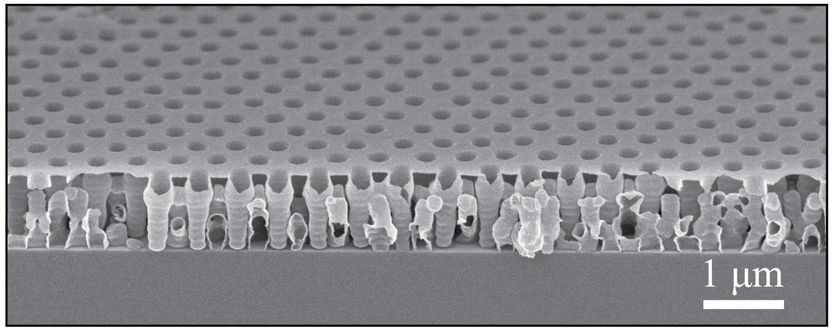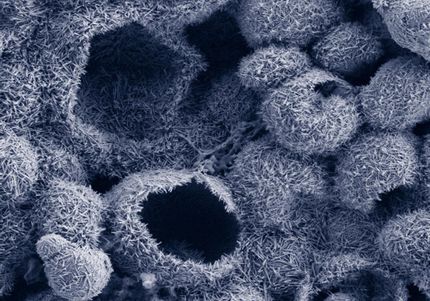Dielectric film has refractive index close to air
Researchers from North Carolina State University have developed a dielectric film that has optical and electrical properties similar to air, but is strong enough to be incorporated into electronic and photonic devices - making them both more efficient and more mechanically stable.

By manipulating the structure of aluminum oxide, a dielectric material, researchers were able to improve its optical and mechanical properties. The key to the film's performance is the highly-ordered spacing of the pores, which gives it a more mechanically robust structure without impairing the refractive index. You can see the structure here, on the micrometer scale.
Chih-Hao Chang
At issue is something called refractive index, which measures how much light bends when it moves through a substance. Air, for example, has a refractive index of 1, while water has a refractive index of 1.33 - which is why a straw appears to bend when you put it in a glass of water.
Photonic devices require a high contrast between its component materials, with some components having a high refractive index and others have a low one. The higher the contrast between those materials, the more efficient the photonic device is - and the better it performs. Air has the lowest refractive index, but it isn't mechanically stable. And the lowest refractive index found in solid, naturally occurring materials is 1.39.
But now researchers have developed a film made of aluminum oxide that has a refractive index as low as 1.025 but that is mechanically stiff.
"By manipulating the structure of the aluminum oxide, which is dielectric, we've improved both its optical and mechanical properties," says Chih-Hao Chang, corresponding author of a paper on the work and an assistant professor of mechanical and aerospace engineering at NC State. Dielectrics are insulator materials that are used in an enormous array of consumer products. For example, every handheld device has hundreds of capacitors, which are dielectric components that can store and manage electric charge.
"The key to the film's performance is the highly-ordered spacing of the pores, which gives it a more mechanically robust structure without impairing the refractive index," says Xu Zhang, lead author of the paper and a Ph.D. student at NC State.
The researchers make the film by first using a nanolithography developed in Chang's lab to create highly-ordered pores in a polymer substrate. That porous polymer then serves as a template, which the researchers coats with a thin layer of aluminum oxide using atomic layer deposition. The polymer is then burned off, leaving behind a three-dimensional aluminum oxide coating.
"We are able to control the thickness of the aluminum oxide, creating a coating between two nanometers and 20 nanometers thick," Zhang says. "Using zinc oxide in the same process, we can create a thicker coating. And the thickness of the coating controls and allows us to design the refractive index of the film." Regardless of the how thick the coating is, the film itself is approximately one micrometer thick.
"The steps in the process are potentially scalable, and are compatible with existing chip manufacturing processes," Chang says. "Our next steps include integrating these materials into functional optical and electronic devices."
Original publication
Zhang, Xu A. and Bagal, Abhijeet and Dandley, Erinn C. and Zhao, Junjie and Oldham, Christopher J. and Wu, Bae-Ian and Parsons, Gregory N. and Chang, Chih-Hao; "Ordered 3D Thin-Shell Nanolattice Materials with Near-Unity Refractive Indices"; Advanced Functional Materials; 2015
Original publication
Zhang, Xu A. and Bagal, Abhijeet and Dandley, Erinn C. and Zhao, Junjie and Oldham, Christopher J. and Wu, Bae-Ian and Parsons, Gregory N. and Chang, Chih-Hao; "Ordered 3D Thin-Shell Nanolattice Materials with Near-Unity Refractive Indices"; Advanced Functional Materials; 2015
Other news from the department science

Get the chemical industry in your inbox
By submitting this form you agree that LUMITOS AG will send you the newsletter(s) selected above by email. Your data will not be passed on to third parties. Your data will be stored and processed in accordance with our data protection regulations. LUMITOS may contact you by email for the purpose of advertising or market and opinion surveys. You can revoke your consent at any time without giving reasons to LUMITOS AG, Ernst-Augustin-Str. 2, 12489 Berlin, Germany or by e-mail at revoke@lumitos.com with effect for the future. In addition, each email contains a link to unsubscribe from the corresponding newsletter.


























































